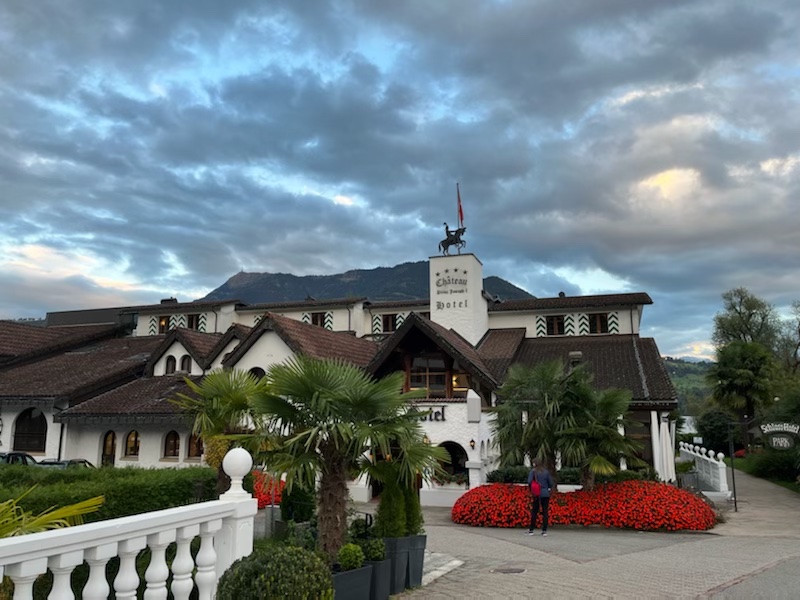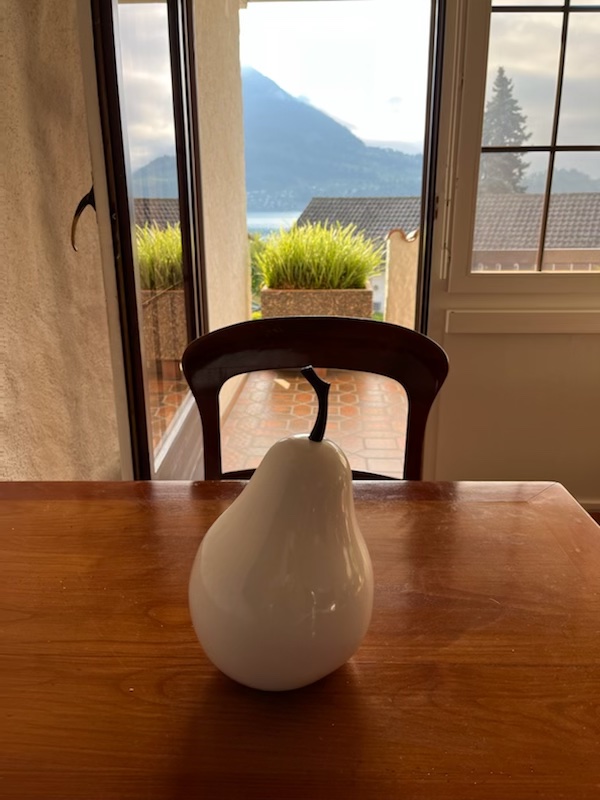
The scene from my room’s balcony encompasses a shimmering finger of Lake Lucerne and a green foothill of Mt. Rigi, a 6000-ft. Alpine mountain towering over the village of Merlischachen. In the middle, a wash of snowcaps glistens to form the perfect vanishing point.
The jagged peaks of Mt. Pilatus form the biggest part of Merlischachen’s backdrop, but these lie just outside my frame. Once you walk a few paces from the hotel, they rise up and pierce the clouds.
Mt. Pilatus is the superstar of Lucerne. My group came here to do exactly what tourists have done for decades: scale its sheer cliffs. Only we did it in modern cable cars. People do climb the mountain, but the thought is daunting.
The engineering needed to erect the powerful towers and pedestals that support the thick cables propelling these cars is impressive; the genius involved in constructing platforms and terraces that jut out from the perilous precipices (not to mention the modern cafe and hotel at the top) simply rattles my brain.
At 7000 ft., Pilatus does not rival the highest Rockies in height, but its needle-point cliffs do! From a distance, Pilatus resembles the tail of a twisting dragon. That’s one of the reasons why this mountain appears in action films, like the 1969 James Bond classic On Her Majesty’s Secret Service.
There’s a legend that Pontius Pilate, his soul troubled, wandered the earth, came to this mountain and ultimately drowned himself in Lake Lucerne. That may be a stretch, but the legend is marvelous. Still, with all of Pilatus’ glory, I find myself more fascinated by our little hotel right now.
What a hotel! Called a chalet-castle, its story is grand. It all began with a Renaissance farm in Merlischachen, a village outside of Lucerne. The large barns and homestead had fallen into disrepair. Yet the biggest barn still served as a kind of way-station for Alpine travelers. Early in the 1950s, a man named Joseph Seeholzer decided to purchase the farm, renovate the big barn, and turn it into a proper hotel. His hostel went from open haylofts with beds of straw to a regular inn. Soon Seeholzer added a restaurant. Then he purchased an old chalet next door and renovated it gorgeously. Finally, he bought the green space across the road at the shore of the lake along and built a large castle-like chalet.

The word “castle” applies because Seeholzer, spurred forth by the love he developed for English monarchy while a student in London, modeled his hotel-chalet after a medieval English castle. The structure includes huge wooden beams, rustic balconies, and stone floors in the passageways. A collection of knights’ armor adorns the walls. To top it all, Seeholzer adopted for himself the name of “Prince Joseph I,” so as to add more cache to his paradise.
 I’m not sure medieval castles had mezzanines, but this castle does. A fancy Nepresso (cappucino) machine graces one end, somewhat breaking the atmosphere. To counter this anachronism, a stand of classic books lines a table, including multiple volumes of the famous Brockhaus German Dictionary and a 19th-century edition of German writers like Goethe, Schiller, and Heine. Apparently, Prince Joseph I knew what mattered.
I’m not sure medieval castles had mezzanines, but this castle does. A fancy Nepresso (cappucino) machine graces one end, somewhat breaking the atmosphere. To counter this anachronism, a stand of classic books lines a table, including multiple volumes of the famous Brockhaus German Dictionary and a 19th-century edition of German writers like Goethe, Schiller, and Heine. Apparently, Prince Joseph I knew what mattered.
One other thing that he knew was symbolism. Ceramic pears placed here and there distinguish this hotel’s décor. You could argue that these are a quirk of some decorator (that is what the young desk clerk guessed).
But, I suspect the pears refer back to the tree that gave the death blow to 29-year old Belgian Queen Astrid on August 22, 1935. That fateful morning, the king and queen had decided to take one last scenic drive and tuck a final hike into their schedule before departing for Brussels. Alas, their car, driven by the King hit a gap in the pavement, spun out of control, and careened into a large pear tree, where the queen’s skull was smashed to pieces.
The tragedy of her death was received world-wide much like the auto crash of Princess Diana, although with a different import of loss. This woman was a reigning queen, a beloved wife, the mother of royal young children, and a figurehead for a nation that adored her. People here still speak about “the accident” in hushed tones. I’m fairly sure the pears are a testament to this tragedy.
History is a funny thing. It can seem so abstract and impersonal when printed in a book. Young people struggle to grasp it, or to know what use to make of it when they do grasp it.
But when history gets pinned to something local, something small enough to fit into their view, history becomes beguiling. The dreaded word “history” reverts back to its core meaning of a story. After all, what kid wouldn’t like the idea of renaming himself “Prince Joseph I” while reconstructing a Renaissance village into his own castle complex?
That is the reason I use the phrase “Teaching History through the Lens of the Arts” to describe our mission. History, illuminated by the sound of music, the color of art, and the movement of dance and theater, becomes irresistible. Figures of history (like our self-styled Prince Joseph I) rarely are dull. Their actions are filled with color and sound. Their victories ring with pageantry, while tragedies lie just around the next curve of the road.



